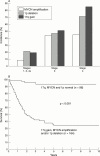Neuroblastoma tumour genetics: clinical and biological aspects
- PMID: 11729208
- PMCID: PMC1731335
- DOI: 10.1136/jcp.54.12.897
Neuroblastoma tumour genetics: clinical and biological aspects
Abstract
Neuroblastoma tumour cells show complex combinations of acquired genetic aberrations, including ploidy changes, deletions of chromosome arms 1p and 11q, amplification of the MYCN oncogene, and-most frequently-gains of chromosome arm 17q. Despite intensive investigation, the fundamental role of these features in neuroblastoma initiation and progression remains to be understood. Nonetheless, great progress has been made in relating tumour genetic abnormalities to tumour behaviour and to clinical outcome; indeed, neuroblastoma provides a paradigm for the clinical importance of tumour genetic abnormalities. Knowledge of MYCN status is increasingly being used in treatment decisions for individual children, and the clinical value of 1p and 17q data as adjuncts or refinements in risk stratification is under active investigation. Reliable detection of these molecular cytogenetic features should be regarded as mandatory for all new cases at presentation.
Figures



References
Publication types
MeSH terms
Substances
LinkOut - more resources
Full Text Sources
Other Literature Sources
Medical
